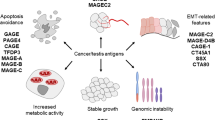Abstract
Present chemotherapeutic drugs have limited efficacy and severe side effects. Considering the complexity of cancer, an effective strategy is necessary to discover multiple new drug targets. Cancer/testis antigens are vital for cancer cell progression. We have performed a computational network analysis of cancer/testis antigens and assessed these antigens as drug targets. During this analysis, protein interaction network of 700 human CT antigens was investigated. CT antigen network consisted of eight independent components. Four major hubs and two minor hubs were identified that play nodal role in the flow of information across the largest network. We have predicted 30 potential drug targets by analysing several topological parameters such as betweenness centrality, cluster coefficient and probable protein complexes. Structural and functional roles of potential drug targets have also been anatomized. Analysis of the CT antigen network enables us to pinpoint a set of candidate proteins that if targeted could be detrimental for cancerous cell without affecting any normal cell. The list of putative proteins is a starting point for experimental validation and may help further in the discovery of new anticancer drug targets.







Similar content being viewed by others
References
Siegel RL, Miller KD, Jemal A. Cancer statistics, 2015. CA Cancer J Clin. 2015;65(1):5–29. doi:10.3322/caac.21254.
Boulikas T, Vougiouka M. Recent clinical trials using cisplatin, carboplatin and their combination chemotherapy drugs (review). Oncol Rep. 2004;11(3):559–95.
Walker PR, Smith C, Youdale T, Leblanc J, Whitfield JF, Sikorska M. Topoisomerase II-reactive chemotherapeutic drugs induce apoptosis in thymocytes. Cancer Res. 1991;51(4):1078–85.
Einhorn LH, Donohue J. Cis-diamminedichloroplatinum, vinblastine, and bleomycin combination chemotherapy in disseminated testicular cancer. 1997. J Urol. 2002;167(2 Pt 2):928–32 .discussion 933
von der Maase H, Hansen SW, Roberts JT, Dogliotti L, Oliver T, Moore MJ, Bodrogi I, Albers P, Knuth A, Lippert CM, Kerbrat P, Sanchez Rovira P, Wersall P, Cleall SP, Roychowdhury DF, Tomlin I, Visseren-Grul CM, Conte PF. Gemcitabine and cisplatin versus methotrexate, vinblastine, doxorubicin, and cisplatin in advanced or metastatic bladder cancer: results of a large, randomized, multinational, multicenter, phase III study. J Clin Oncol. 2000;18(17):3068–77.
Rehman FL, Lord CJ, Ashworth A. Synthetic lethal approaches to breast cancer therapy. Nat Rev Clin Oncol. 2010;7(12):718–24. doi:10.1038/nrclinonc.2010.172.
Suri A. Cancer testis antigens—their importance in immunotherapy and in the early detection of cancer. Expert Opin Biol Ther. 2006;6(4):379–89. doi:10.1517/14712598.6.4.379.
Buonaguro L, Tagliamonte M, Tornesello ML, Buonaguro FM. Developments in virus-like particle-based vaccines for infectious diseases and cancer. Expert Rev Vaccines. 2011;10(11):1569–83. doi:10.1586/erv.11.135.
Caballero OL, Chen YT. Cancer/testis (CT) antigens: potential targets for immunotherapy. Cancer Sci. 2009;100(11):2014–21. doi:10.1111/j.1349-7006.2009.01303.x.
Jager D, Stockert E, Scanlan MJ, Gure AO, Jager E, Knuth A, Old LJ, Chen YT. Cancer-testis antigens and ING1 tumor suppressor gene product are breast cancer antigens: characterization of tissue-specific ING1 transcripts and a homologue gene. Cancer Res. 1999;59(24):6197–204.
Kalejs M, Erenpreisa J. Cancer/testis antigens and gametogenesis: a review and “brain-storming” session. Cancer Cell Int. 2005;5(1):4. doi:10.1186/1475-2867-5-4.
Peche LY, Ladelfa MF, Toledo MF, Mano M, Laiseca JE, Schneider C, Monte M. Human MageB2 protein expression enhances E2F transcriptional activity, cell proliferation, and resistance to ribotoxic stress. J Biol Chem. 2015;290(49):29652–62. doi:10.1074/jbc.M115.671982.
Sati L, Zeiss C, Yekkala K, Demir R, McGrath J. Expression of the CTCFL Gene during mouse embryogenesis causes growth retardation, postnatal lethality, and dysregulation of the transforming growth factor beta pathway. Mol Cell Biol. 2015;35(19):3436–45. doi:10.1128/mcb.00381-15.
Woloszynska-Read A, James SR, Link PA, Yu J, Odunsi K, Karpf AR. DNA methylation-dependent regulation of BORIS/CTCFL expression in ovarian cancer. Cancer Immun. 2007;7:21.
Andrade VC, Vettore AL, Felix RS, Almeida MS, Carvalho F, Oliveira JS, Chauffaille ML, Andriolo A, Caballero OL, Zago MA, Colleoni GW. Prognostic impact of cancer/testis antigen expression in advanced stage multiple myeloma patients. Cancer Immun. 2008;8:2.
Kikuchi E, Yamazaki K, Nakayama E, Sato S, Uenaka A, Yamada N, Oizumi S, Dosaka-Akita H, Nishimura M. Prolonged survival of patients with lung adenocarcinoma expressing XAGE-1b and HLA class I antigens. Cancer Immun. 2008;8:13.
Cho HJ, Caballero OL, Gnjatic S, Andrade VC, Colleoni GW, Vettore AL, Outtz HH, Fortunato S, Altorki N, Ferrera CA, Chua R, Jungbluth AA, Chen YT, Old LJ, Simpson AJ. Physical interaction of two cancer-testis antigens, MAGE-C1 (CT7) and NY-ESO-1 (CT6). Cancer Immun. 2006;6:12.
Kar G, Gursoy A, Keskin O. Human cancer protein-protein interaction network: a structural perspective. PLoS Comput Biol. 2009;5(12):e1000601. doi:10.1371/journal.pcbi.1000601.
Oba-Shinjo SM, Caballero OL, Jungbluth AA, Rosemberg S, Old LJ, Simpson AJ, Marie SK. Cancer-testis (CT) antigen expression in medulloblastoma. Cancer Immun. 2008;8:7.
Bader GD, Hogue CW. An automated method for finding molecular complexes in large protein interaction networks. BMC Bioinformatics. 2003;4:2.
Zeidan-Chulia F, Gursoy M, Neves de Oliveira BH, Ozdemir V, Kononen E, Gursoy UK. A systems biology approach to reveal putative host-derived biomarkers of periodontitis by network topology characterization of MMP-REDOX/NO and apoptosis integrated pathways. Front Cell Infect Microbiol. 2015;5:102. doi:10.3389/fcimb.2015.00102.
Goh KI, Cusick ME, Valle D, Childs B, Vidal M, Barabasi AL. The human disease network. Proc Natl Acad Sci U S A. 2007;104(21):8685–90. doi:10.1073/pnas.0701361104.
Florez AF, Park D, Bhak J, Kim BC, Kuchinsky A, Morris JH, Espinosa J, Muskus C. Protein network prediction and topological analysis in Leishmania major as a tool for drug target selection. BMC Bioinformatics. 2010;11:484. doi:10.1186/1471-2105-11-484.
Hopkins AL. Network pharmacology: the next paradigm in drug discovery. Nat Chem Biol. 2008;4(11):682–90. doi:10.1038/nchembio.118.
Acknowledgments
Authors are thankful to SERB, Dept. of Science and Technology (DST), Govt. of India for providing financial assistance to the lab. Authors would also like to acknowledge the help and guidance received by Dr. Vishal Acharya, IHBT, Palampur, while preparing manuscript.
Author information
Authors and Affiliations
Corresponding authors
Rights and permissions
About this article
Cite this article
Kumar, A., Sharma, D., Aggarwal, M.L. et al. Cancer/testis antigens as molecular drug targets using network pharmacology. Tumor Biol. 37, 15697–15705 (2016). https://doi.org/10.1007/s13277-016-5333-2
Received:
Accepted:
Published:
Issue Date:
DOI: https://doi.org/10.1007/s13277-016-5333-2




